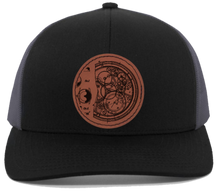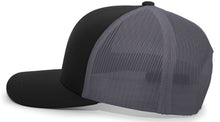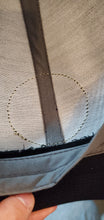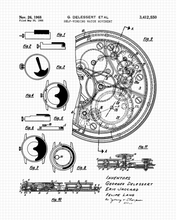Vintage Watch Mechanical Movement Patent 1956 Automatic self-winding watch movement engraved Leather Patch hat, Industrially sewn on by hand to ensure the highest quality!
Adjustable size- 6 3/8 (51cm) to 8 (64cm)
A mesh hat has the ability to let your head breathe. All of the heat will get released through the mesh so the sweat doesn't build.
Custom logos or designs are always available under our design your own engraved products, Design your own leather patch hats online here, Patches are engraved and sewn on, and patch options will be round, oval, and rectangular.
"Get Inspired" with JTM VINTAGE  ®
®
History facts:
The history of mechanical timepieces is quite extensive. It can be interesting to look back at how technology has given mechanical watches a 180 degree turn in their function and appearance.
The first watch ever recorded timepiece was the sundial in approximately 3500 BC. This was a generally large outdoor structure that could tell the time of the day via the position of the sun in the sky. In 1400 BC, by measuring the time it took to burn candles, incense, and oil, some cultures began to invent knew ways of capturing the essence of time.
In 300 BC, Archimedes invented the first transmission gears. In this same year, sand glass clocks were introduced. In the year 885, candles that had time markings were introduced to medieval Europe. In 1092, Chinese innovator Su Sung was the creator of the first mechanical water clock.
Finally, in the late 13th century, the first mechanical clocks were built, while the first mechanical clock tower was built in 1335, in Milan, Italy. Water clocks were slowly replaced by mechanical clocks throughout this age. Meanwhile, in England, the first mechanical clockmaker’s (horologists) appeared in 1368. The introduction of the first small domestic table clocks appeared in the early 1500s.
In 1510, the first mechanical watch was invented in Germany by Peter Henlein. This watch could only measure the passage of the hours and could only be carried around the neck or fastened to belts. You certainly don’t see many people wearing their watches around their belt or neck nowadays, although we do have some beautiful tourbillon movement necklaces.
Mechanical watches were the ones that changed the common practice of measuring time. In 1540, screws began to be utilized on clocks. In 1610, glass protection on watches was presented in the watch market, and quickly became adapted in higher end watches.
In 1676, the minute hand for watches was presented by Daniel Quare. In 1840, the first electric clock was created, while in 1895, the first modern electric clock was created. In the 1900s, personal mechanical watches and clocks enter into mass production via industrialization and mass production of varies parts. Fast forward to present day, and we have a mix between technology, modern design, and classic horology.
It has been estimated that every year, over half a billion mechanical watches are sold around the globe. Thanks to all of these advances, we can now have innovative mechanical watches. We’ll just have to wait and see what other innovative mechanical watch creations enter the market in the next couple of decades.







